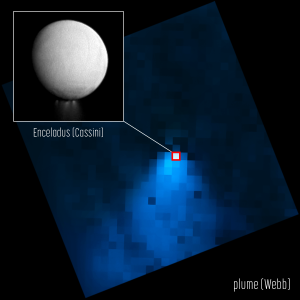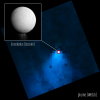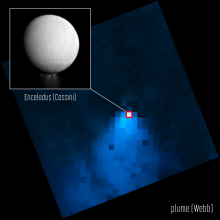Moon and Saturn [1]
One of the moons of Saturn is like a water sprinkler that won’t turn off — it sprays everything around it. It provides the water and ice that make up one of Saturn’s rings, and squirts more water throughout the entire Saturn system.
Enceladus is about 300 miles in diameter. In 2005, the Cassini spacecraft discovered “geysers” of water shooting into space from the moon’s south pole. Later, Cassini even flew through the geysers, measuring their composition.
The water comes from a global ocean below the moon’s icy crust. “Vents” of hot water may shoot into the ocean from below, bringing along a variety of minerals. That appears to give Enceladus all the ingredients for life.
Late last year, James Webb Space Telescope took a look at Enceladus. It found that the geysers are still there, shooting out enough water to fill an Olympic pool in about two hours. They merge to form a “plume” that extends more than 6,000 miles from Enceladus. The moon orbits Saturn once every 33 hours, so the plume spreads out, forming a “doughnut” of ice around Saturn. The planet’s outermost ring lies within the doughnut, so it’s resupplied by the plume. But about two-thirds of the water spreads out, forming a thin, cold “fog” throughout Saturn’s rings.
Saturn is in great view tonight. It’s just a few degrees from the gibbous Moon — the width of a couple of fingers held at arm’s length. It looks like a bright star.
Script by Damond Benningfield


